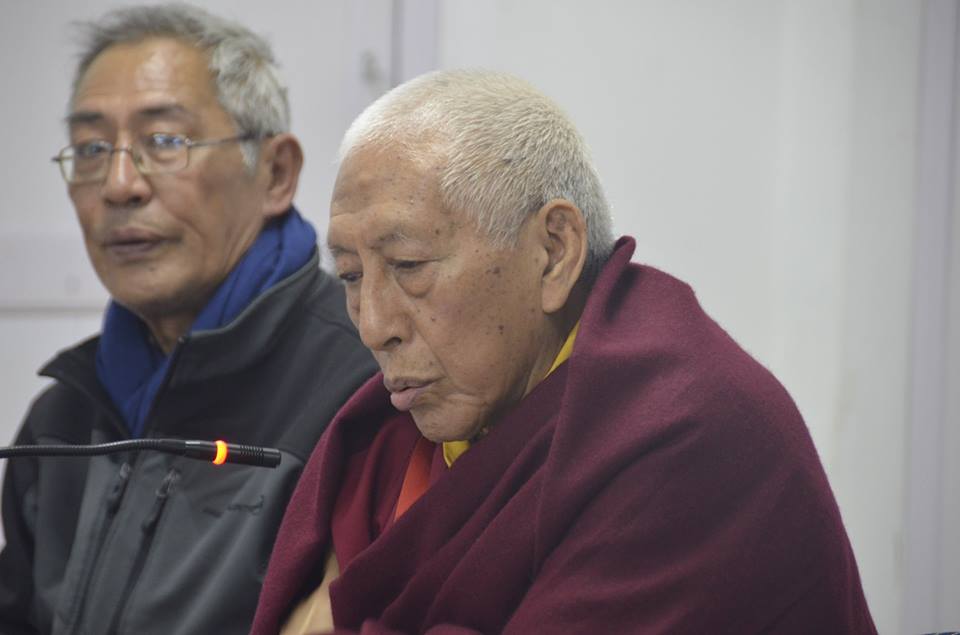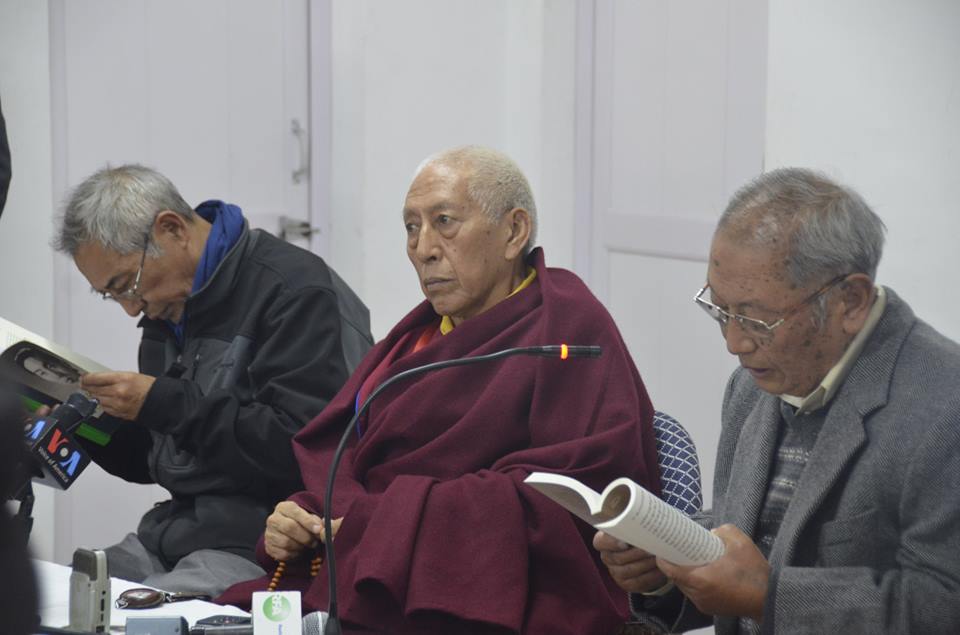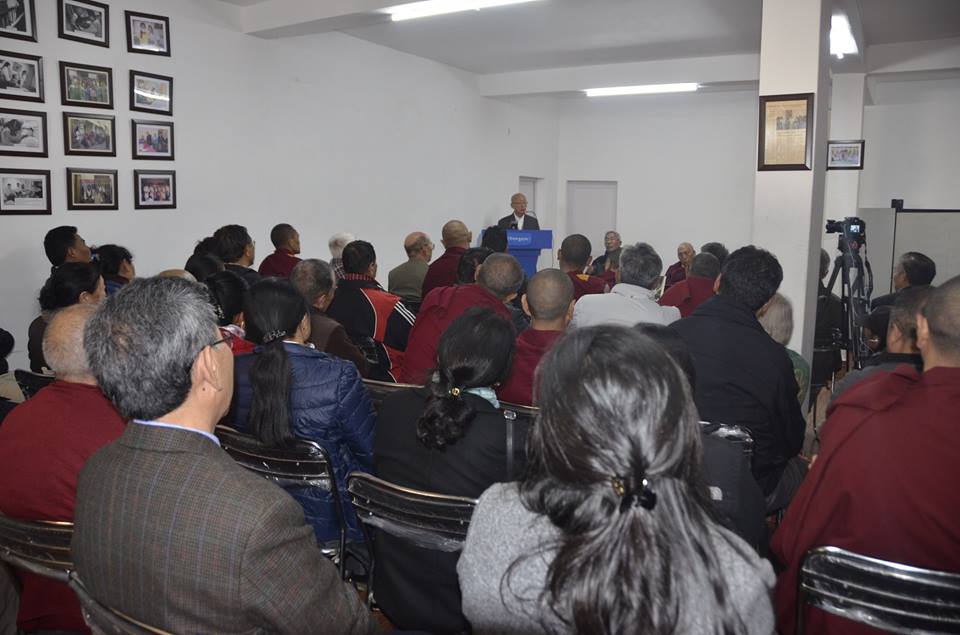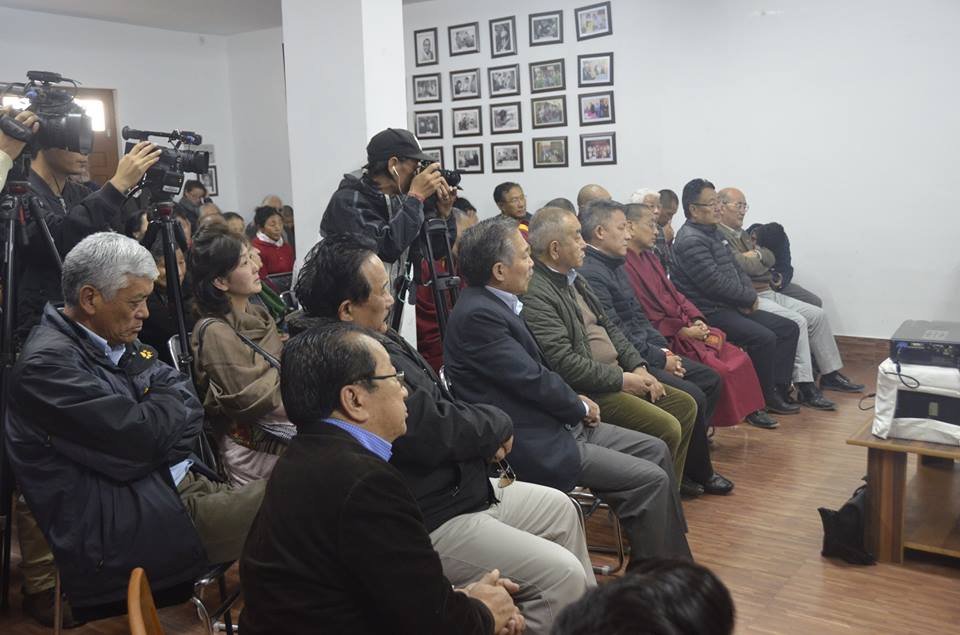Speech at the launch of autobiography of the late former Kalon, Mr Sadutshang Rinchen Dhondup
In the late afternoon of 4 December 2017 His Eminence Prof. Samdhong Rinpoche formally launched, for the event organisers, in the hall of Delek Hospital, Gangchen Kyishong, Dharamshala, the autobiography (A Life Unforeseen—A Memoir of Service to Tibet; published by LTWA) of the former Kalon, Mr Sadhutshang Rinchen Dhondup. His Eminence Rinpoche also gave a felicitation speech.
His Eminence Prof. Samdhong Rinpoche was the Chief Guest; the dignitaries in attendance were Mr Losang Dhargye (the former senior Justice of the Central Tibetan Administration), Mr Thupten Samphel (Director, Tibetan Policy Research Centre), Dr Nawang Rabgye (Justice Commissioner), the honourable ministers, the members of the standing committee of Tibetan People’s Deputies, department secretaries, and others, comprising of over a hundred persons.
Dr Tseten gave a brief introduction of his late father’s life account, followed by excerpt recital in Tibetan, from the autobiography, by the former senior justice Mr Losang Dhargye, and excerpt recital in English, by Mr Thupten Samphel.
Thereafter, His Eminence Prof. Samdhong Rinpoche gave a speech:
I am very glad to be able to attend the launch of the honourable Sadu Rinchen’s (Sadutshang Rinchen’s) autobiography in Tibetan and English (the English version was published by Wisdom Publications in 2016). To put in writing an individual’s life account is a custom found both in traditional and modern norms. Particularly in the tradition of societies in the east, there has been the custom of writing other’s biography and one’s own autobiography. In Tibet, biographies and autobiographies of sublime teachers (lamas) abound; they are called “liberating accounts” (liberating life stories; rnam-thar); in classical India, they were called “realisation narratives,”avadāna)—if it was of the present life, it was called “realisation narratives,” if it was of previous lives, it was called “[former] lives[’ narratives],” jātaka, (lives chronicle), which can be either self-authored or written by others.
For instance, with the Buddha, Abhiniṣkramaṇa Sūtra (Emergence Discourse) and Lalitavistara Sūtra (Extensive Displays Discourse) are like autobiographies; biographical ones are those written by others, such as, Buddhacārita (Buddha Deeds), a major poetical biography, and so forth.
When Mahatma Gandhi was writing his autobiography My Experiment with Truth an Indian scholar questioned Gandhi on the appropriateness of doing so, saying that it isa western custom to write autobiographies, that it was not in the eastern culture. Gandhi countered that by pointing out that in Indian history there had been the ancient Indian culture of writing one’s own life accounts and of writing others,’ and because of that Gandhi was writing his own life accounts.
The purpose of biographical works are as Jey Rinpoche Tsongkhapa said, that one would rejoice on things one has done well, to accept the mistakes one has made and to remorsefully declare them, and through that the readers would in their lives adopt the positives and eschew the negatives.
Apart from sublime teachers, there were very few in the Tibetan society from amongst the lay who wrote of their life accounts; there were one or two—such as, Miwang Sonam Topgyal. Yet, subsequent to arriving in exile since 1959 there emerged a time of great changes, forcibly by events of time, with our situation, in terms of Tibet as a nation, for its populace, spirituality and culture. Fortunately, it was solely the leadership of His Holiness the Dalai Lama that saved us from the situation then, otherwise it would have become a state of not knowing what to do. The time of changes then would be what is in western parlance called ‘in a period of transition.’
It was not a natural gradual change, rather what I usually say to my acquaintances, that we arrived in one jump from a 7th century civilization into the 20th century civilization, and that we were able to do so in one jump was because we had a sublime leadership.
The life accounts of many important persons of that time have become an important part of the history of Tibetans and Tibet. If it were a time of peace and stability there is no certainly for life situations of an ordinary citizen, trader, an individual person, to become a part of the history of a nation and its people.
Since the Tibetan situation during the period between 1951 till around 1960 was an unprecedentedly peculiar one, it is a factual thing that the narratives of an individual’s life of that time become an important part of the race’s and the nation’s history—particularly the individual narratives of those who had served in the Tibetan government under the leadership of His Holiness the Dalai Lama, during the time Tibet was an independent nation, and during the subsequent time bereft of independence.
As such, His Holiness frequently advises the administrative staff members and the elders who have a long experience of the society that it would be good to put into writing their life stories, more so of the details of the services rendered. Accordingly, many senior government service personnel and important persons in the society have written their life accounts.
When one puts in writing one’s life story many details get included in confluence, unlike in other situations. For instance, the history of one’s region of birth would appear in it, otherwise perhaps we might gradually forget them. If it were someone born in Ngari the details of the region, the society, weather and so forth, would be the parts included when the person writes one’s life story. These become some of the best resources for researchers.
In accordance with the advice and thoughts of His Holiness the Dalai Lama the Library of Tibetan Works and Archives has established a separate section for Oral History. For those who are not able to write themselves their life accounts have been compiled from oral interviews; many of those who are able to write by themselves have written their life stories with advice from His Holiness.
From amongst them, one such is of the late honourable former Kalon, Sadu Rinchen, which is to be launched here today. Rinchen-la’s(respected Richen’s) life account is special. When I was at monastic seat in Tibet I did not know anything about him, but even from a young age at the monastic seat I had heard of the family name “Sadutshang”. That was because Sadutshang family was one of the best benefactors of the reincarnate lamas and of the monasteries of all denominations. All the benefactors from Sadutshang used to frequently visit Kyabjey Trijang Rinpoche; they also used to visit Kyabjey Ling Rinpoche. For the monastic scholars who were poor, those who studied hard but were impoverished of sustenance, and especially those who were good scholars graduating as a Geshe but were without sufficient funds to make the Graduating Offerings, Kyabjey Trijang Rinpoche had some benefactors where the scholars would be sent; it was to Sadutshang’s the most number of scholars were sent. From that time the name had set in our ears. They were amongst those who had large family mansions in Lhasa.
As Dr Tseten has mentioned earlier, the first time the teachings from His Holiness the Dalai Lama on voice amplification system/public broadcast systemwas at Monlam Prayer Festival of 1952. I was there at that time. All of the large audience were able to hear the teachings. When a public broadcast system was first set there was a crew of only two or three persons. At that time those who were seated close to His Holiness had difficulty hearing well from the echoes. Later, when the first Kalachakra Empowerment was bestowed at Chensel Gardens the earlier echo problem had been solved. When the teachings by His Holiness were from the Palace the voice amplification system was not being used, it was being used when the teachings were to a large audience. It was a kind of innovation at that time.
Why the situation of the late honourable former Kalon Rinchen-la is special is because his was one of the first government service personnel from the family of a major trader who was not one of those hereditary government officials in the pre-1959 era in Tibet when the country was going well spiritually and politically. I think perhaps he was the first of the government officials at Shoy versed in Tibetan and English; apart from one or two who were sent abroad for studies during the time of His Holiness the Thirteenth Dalai Lama he would be one of the first from amongst the new officials.
As I said earlier, as such, a person such as the late honourable Rinchen-la is rare, one who had taken part in important works during a period of a major transition. Prior to entering the government service, even when at school he had helped and co-operatively endeavoured in many works; for instance, when in 1945 a Tibetan envoy was sent for congratulating the allied victory, Rinchen-la was there when calling upon the British Viceroy, and when calling upon the American ambassador. Moreover, of great importance was that, also when a Tibetan delegation was sent to China for deliberations on The Seventeen Points, Rinchen-la was among the delegations who came from India.
His Holiness the Dalai Lama has recognised Rinchen-la as a person of integrity, calm and steady. In particular, after arriving in exile, Rinchen-la was a part of one of the most important movements during 1959 – 1960: the Tibetan appeal made three times to the United Nations; during all of them Rinchen-la participated actively, as Dr Tseten mentioned earlier; perhaps Mr Gyalo-la was together.
This autobiography therefore has become a valuable account. From its version in English many things related with Tibetan political events and society can be understood well. The Tibetans not versed in English can know many things from the Tibetan version, such as, the political situation of Tibet during the times of our forebears; the hardships encountered during the discussions on The Seventeen Points; the subsequent appeals made to the United Nations; the relationship between Tibet and British-ruled India prior to India’s independence; the contacts made with the Indian leaders by the delegates for The Seventeen Points travelling via India from Lhasa. The autobiography would be greatly helpful for understanding these and many other things.
With these above words of felicitation, His Eminence Rinpoche then formally launched the book.



